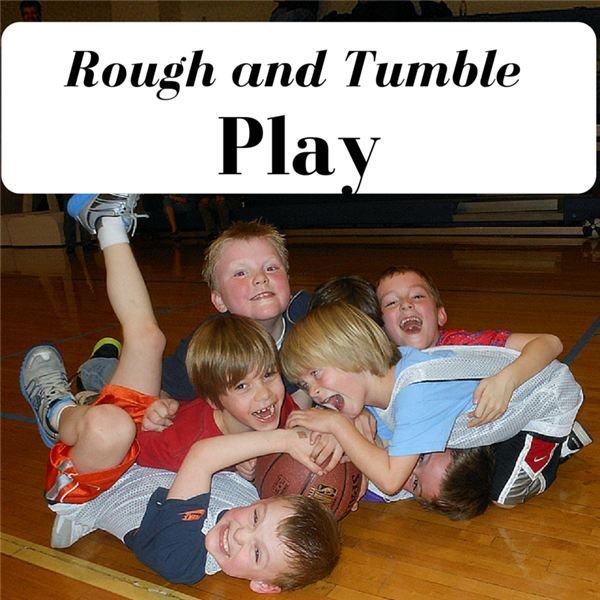The Importance of Rough and Tumble Play for Young Children
What It Is
Research supports the idea of “rough and tumble” play. But what exactly is it? It can be played with others or can be solitary. Some examples include:
- Dancing
- Hopscotch
- Climbing up and jumping off
- Wrestling
- Roughhousing
- Play fighting
- Tickling
- Tag
- Football
- Duck-Duck-Goose
Although rough play tends to be discouraged and viewed as aggressive or dangerous, it is a viable part of a child’s play development from infancy through the primary years. Rough play is beneficial to children in many ways. Whether it is solitary or with peers, rough play supports a multitude of skills and developmental domains.
What It Is Not
Rough play fighting (or big body play) is not real fighting. During play fighting, children are smiling and laughing. They have relaxed muscles and open palms.
According to the National Association of the Education of Young Children, play fighting only escalates to real fighting one percent of the time, and this may be true due to the lack of supervision from adults and prior social concerns of the children involved (socially rejected or isolated) prior to the play fighting.
Teachers are generally discouraged from allowing children to wrestle or play physical games despite the fact that it is a valuable play option for future skill development. Children participate in physical play for active fun and enjoyment, not to display aggression or hurt another child. Appropriate rough play should be supported and supervised to allow opportunities for many social, physical and cognitive skills.
Read on to learn why it is so important.
Social/Emotional Skills
Rough and tumble play is significant in social skill development. It provides opportunities for children to learn to “read” peers’ body language and facial expressions. Boys may not always feel comfortable to hug each other or say “I like you!” but allowing for physical tough and friendship building through the rough and tumble play gives them the opportunity to express these emotions. In addition, the figuring out of social signals from others and being able to negotiate when problems arise is significant. Other areas benefitting include:
- Promoting positive peer relationships
- Fostering peer interactions
- Turn taking
- Problem solving
- Empathy
- Fairness
- Practice dominance relationships
- Taking on adult roles
- Learn rules to games
- Learn cooperative skills
Physical Development
Children gain a wide range of physical skills through the engagement in rough big body play. How their body moves in space and improving core strength are ways in which children can increase physical development. Others include:
- Balance
- Body control
- Body awareness
- Spatial awareness
- Arm/hand strengthening for prewriting skills
- Nurturing touch
Cognitive Skills
As mentioned earlier, physical movement supports cognitive growth and development. Roughhousing stimulates neuron growth within the cortex and hippocampus regions of the brain, responsible for memory, learning, language and logic.
Ways children can use rough and tumble play to help improve cognitive function include:
- Creativity
- Attention to task
- Confidence
- Release of chemicals in brain that support growth
- May lead to pretend play such as super heroes, ninja, playing house, sword fighting, etc.
Teacher’s Role
Teachers play a vital role in both the set up and control of rough and tumble play. The guidelines must be presented and discussed at the beginning of the year.
Also, creating an environment that supports safe and appropriate rough play with designated areas and teacher supervision. Provide materials that allow for building and climbing, balls, exercise mats, soft furniture, and pillows. The National Association for the Education of Young Children (NAEYC) provides guidelines for policies and rules that guide rough and tumble play. Some suggestions include:
- Setting up specific times
- Allow all children to participate, especially children with developmental disabilities and those who may be socially withdrawn
- Must be in the designated/supervised area
- Equipment rules, such as when a slide can be climbed up or all tumbling must be on a mat
- No hurtful behavior such as hitting or pinching
- Stop when someone says stop
Teachers must supervise and watch for any aggressive behavior or for children who lack the social skills to know how to respond appropriately. Help a child who may not know how to ask for a break or who seems uncomfortable with the rough aspect of the play.
Communicate to Parents
Teacher need to make sure that the parents understand the benefits and the safeguards around rough and tumble play in the classroom. Keep open communication with families concerning the rules and guidelines to allow parents who may not understand the benefits to learn and appreciate the reasons why this play is included in the program.
Children need opportunities to enjoy big body play and benefit from all of the positive outcomes that come with the peer interactions, physical development, and cognitive growth that comes with appropriate and safe rough and tumble play.
References
- Brocker, B. & Hartzog, K. (2007). A Teacher’s Guide to Rough and Tumble Play. Retrieved on March 30, 2016, from http://farpoint.fcs.uga.edu/facs/docs/RoughandTumbleStudy.pdf
- Carlson, F. M. (2011). Rough Play: One of the Most Challenging Behaviors. Young Children. Retrieved on April 5, 2016, from www.NAEYC.com
- Borchard, T. (2015). 6 Benefits of Roughhousing for Kids. Psych Central. Retrieved on April 16, 2016, from http://psychcentral.com/lib/6-benefits-of-roughhousing-for-kids
- Image Source: Dogpile! Flickr.com/supercooper
